(1) Background: forest fire refers to the behavior of forest fire that is out of human control, spreads and expands freely in the forest land, and brings certain harm and loss to the forest, forest ecosystem and human beings. Forest fire is a natural fire with strong sudden, destructive and difficult disposal and rescue. In recent years, due to the intensification of the greenhouse effect, forest fires occur frequently. In this way In the situation of, it is necessary to do a good job in prevention. To achieve 24-hour, all-weather and large-scale monitoring, satellite and UAV patrol are better measures. For UAV patrol, how machines judge the occurrence of fire in the current area, computer vision should be one of the important technologies, so a small program for forest fire picture recognition is designed, I hope to understand computer vision through this design.
(2) Machine learning design case design scheme: download relevant data sets from the website, sort out the data sets, label the files in the data set in the python environment, preprocess the data, use keras to build the network, train the model, and import the picture test model
Reference source: kaggle discussion area on label learning
Data set source: kaggle, website: https://www.kaggle.com/
(3) Implementation steps of machine learning:
1, Second classification
1. Download data set

2. Import the required library
1 #Import required libraries 2 import numpy as np 3 import pandas as pd 4 import os 5 import tensorflow as tf 6 import matplotlib.pyplot as plt 7 from pathlib import Path 8 from sklearn.model_selection import train_test_split 9 from keras.models import Sequential 10 from keras.layers import Activation 11 from keras.layers import Dense, Dropout, Flatten, Conv2D, MaxPooling2D 12 from keras.applications.resnet import preprocess_input 13 from keras_preprocessing.image import ImageDataGenerator 14 from keras.models import load_model 15 from keras.preprocessing.image import load_img, img_to_array 16 from keras import optimizers
3. Traverse the files in the dataset and generate DataFrame from path data and label data
1 dir = Path('D:/python Curriculum design 1/fire') 2 3 # use glob Traversal in dir All in path jpg Format and add all file names to the filepaths In the list 4 filepaths = list(dir.glob(r'**/*.jpg')) 5 6 # Separate the divided small file name (category name) in the file and add it to the labels In the list of 7 labels = list(map(lambda l: os.path.split(os.path.split(l)[0])[1], filepaths)) 8 9 # take filepaths adopt pandas Convert to Series data type 10 filepaths = pd.Series(filepaths, name='FilePaths').astype(str) 11 12 # take labels adopt pandas Convert to Series data type 13 labels = pd.Series(labels, name='Labels').astype(str) 14 15 # take filepaths and Series Two Series Data type composition for DataFrame data type 16 df = pd.merge(filepaths, labels, right_index=True, left_index=True) 17 df = df[df['Labels'].apply(lambda l: l[-2:] != 'GT')] 18 df = df.sample(frac=1).reset_index(drop=True) 19 #View formed DataFrame Data 20 df
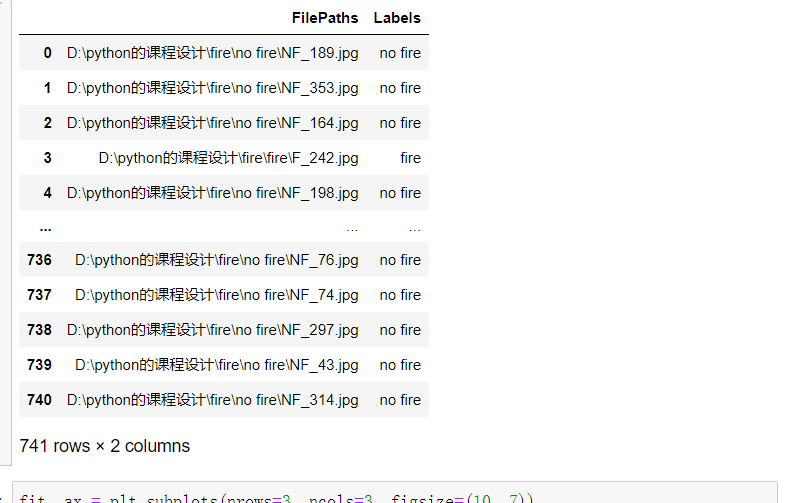
4. View the image and the corresponding label
1 #View the image and the corresponding label 2 fit, ax = plt.subplots(nrows=3, ncols=3, figsize=(10, 7)) 3 4 for i, a in enumerate(ax.flat): 5 a.imshow(plt.imread(df.FilePaths[i])) 6 a.set_title(df.Labels[i]) 7 8 plt.tight_layout() 9 plt.show() 10 11 #View the number of pictures of each label 12 df['Labels'].value_counts(ascending=True)
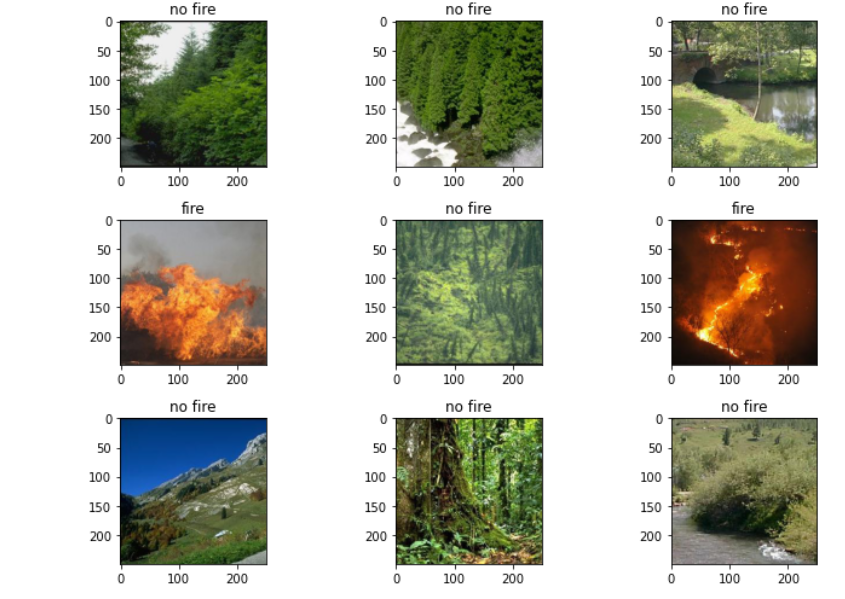
5. The training set, test set and verification set are generated from the total data set
1 #The total data is distributed to the users in a ratio of 10:1 X_train, X_test 2 X_train, X_test = train_test_split(df, test_size=0.1, stratify=df['Labels']) 3 4 print('Shape of Train Data: ', X_train.shape) 5 print('Shape of Test Data: ', X_test.shape) 6 7 # Press 5 for the total data:1 Proportion allocated to X_train, X_train 8 X_train, X_val = train_test_split(X_train, test_size=0.2, stratify=X_train['Labels']) 9 10 print('Shape of Train Data: ', X_train.shape) 11 print('Shape of Val Data: ', X_val.shape) 12 13 # View the number of pictures of each label 14 X_train['Labels'].value_counts(ascending=True)

6. Image preprocessing
1 # Batch size 2 BATCH_SIZE = 32 3 # Enter the size of the picture 4 IMG_SIZE = (224, 224) 5 6 # Image preprocessing 7 img_data_gen = ImageDataGenerator(preprocessing_function=preprocess_input) 8 9 X_train = img_data_gen.flow_from_dataframe(dataframe=X_train, 10 x_col='FilePaths', 11 y_col='Labels', 12 target_size=IMG_SIZE, 13 color_mode='rgb', 14 class_mode='binary', 15 batch_size=BATCH_SIZE, 16 seed=42) 17 18 X_val = img_data_gen.flow_from_dataframe(dataframe=X_val, 19 x_col='FilePaths', 20 y_col='Labels', 21 target_size=IMG_SIZE, 22 color_mode='rgb', 23 class_mode='binary', 24 batch_size=BATCH_SIZE, 25 seed=42) 26 X_test = img_data_gen.flow_from_dataframe(dataframe=X_test, 27 x_col='FilePaths', 28 y_col='Labels', 29 target_size=IMG_SIZE, 30 color_mode='rgb', 31 class_mode='binary', 32 batch_size=BATCH_SIZE, 33 seed=42)

7. View the processed image and its binary tag
#View the processed picture and its binary label fit, ax = plt.subplots(nrows=2, ncols=3, figsize=(13,7)) for i, a in enumerate(ax.flat): img, label = X_train.next() a.imshow(img[0],) a.set_title(label[0]) plt.tight_layout() plt.show()
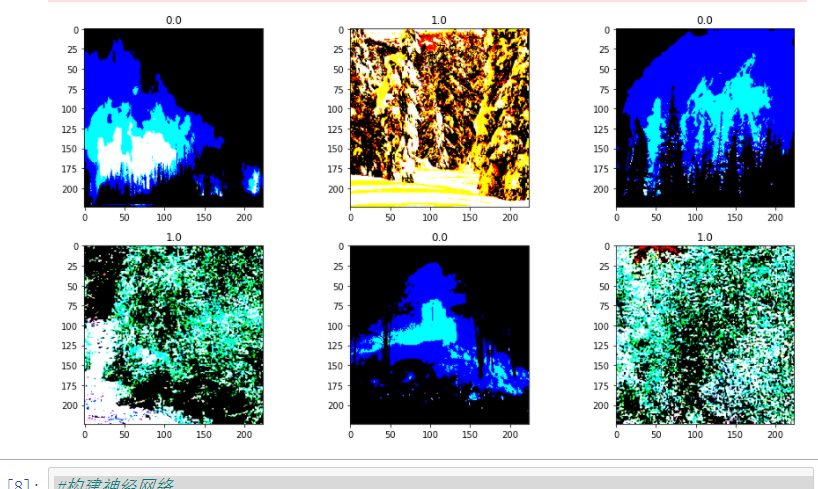
8. The neural network is constructed and the model is trained
#Constructing neural network model = Sequential() # Data normalization processing model.add(tf.keras.layers.experimental.preprocessing.Rescaling(1./255)) # 1.Conv2D Layer, 32 filters model.add(Conv2D(filters=32, kernel_size=(3,3), padding='same', input_shape=(224, 224, 3)))#The graphics are color,'rgb',So set 3 model.add(Activation('relu')) model.add(MaxPooling2D(pool_size=(2,2), strides=2, padding='valid')) # 2.Conv2D Layer, 64 filters model.add(Conv2D(filters=64, kernel_size=(3,3), padding='same')) model.add(Activation('relu')) model.add(MaxPooling2D(pool_size=(2,2), strides=2, padding='valid')) # 3.Conv2D Layer, 128 filters model.add(Conv2D(filters=128, kernel_size=(3,3), padding='same')) model.add(Activation('relu')) model.add(MaxPooling2D(pool_size=(2,2), strides=2, padding='valid')) # The data of the input layer is compressed into one-dimensional data, and the full connection layer can only process one-dimensional data model.add(Flatten()) # Full connection layer model.add(Dense(256)) model.add(Activation('relu')) # Reduce overfitting model.add(Dropout(0.5)) # Full connection layer model.add(Dense(1)) model.add(Activation('sigmoid')) # Model compilation model.compile(optimizer=optimizers.RMSprop(lr=1e-4), loss="categorical_crossentropy", metrics=["accuracy"])#Training model using batch generator
h1 = model.fit(X_train, validation_data=X_val,
epochs=30, )
#Save model
model.save('t1')
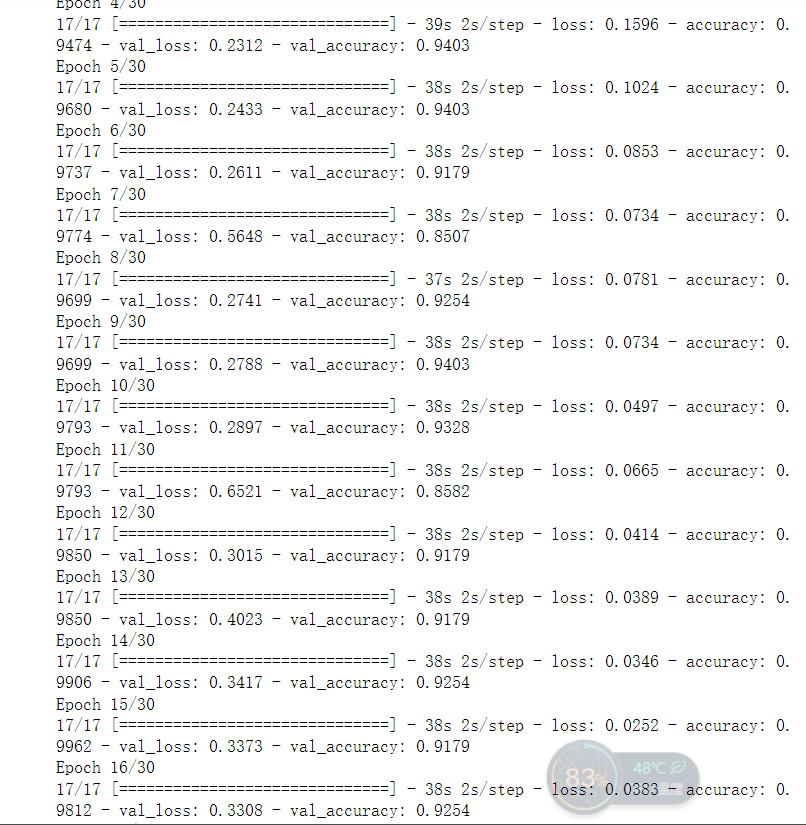
9. Draw loss curve and accuracy curve
1 accuracy = h1.history['accuracy'] 2 loss = h1.history['loss'] 3 val_loss = h1.history['val_loss'] 4 val_accuracy = h1.history['val_accuracy'] 5 plt.figure(figsize=(17, 7)) 6 plt.subplot(2, 2, 1) 7 plt.plot(range(30), accuracy,'bo', label='Training Accuracy') 8 plt.plot(range(30), val_accuracy, label='Validation Accuracy') 9 plt.legend(loc='lower right') 10 plt.title('Accuracy : Training vs. Validation ') 11 plt.subplot(2, 2, 2) 12 plt.plot(range(30), loss,'bo' ,label='Training Loss') 13 plt.plot(range(30), val_loss, label='Validation Loss') 14 plt.title('Loss : Training vs. Validation ') 15 plt.legend(loc='upper right') 16 plt.show()

10. Import pictures for prediction
from PIL import Image def con(file,outdir,w=224,h=224): img1=Image.open(file) img2=img1.resize((w,h),Image.BILINEAR) img2.save(os.path.join(outdir,os.path.basename(file))) file='D:/python Curriculum design of/NA_Fish_Dataset/Black Sea Sprat/F_23.jpg' con(file,'D:/python Curriculum design of/NA_Fish_Dataset/Black Sea Sprat/') model=load_model('t1') img_path='D:/python Curriculum design of/NA_Fish_Dataset/Black Sea Sprat/F_23.jpg' img = load_img(img_path) img = img_to_array(img) img = np.expand_dims(img, axis=0) out = model.predict(img) if out[0]>0.5: print('The probability of fire is',out[0]) else: print('Not a fire') img=plt.imread('D:/python Curriculum design of/NA_Fish_Dataset/Black Sea Sprat/F_23.jpg') plt.imshow(img)
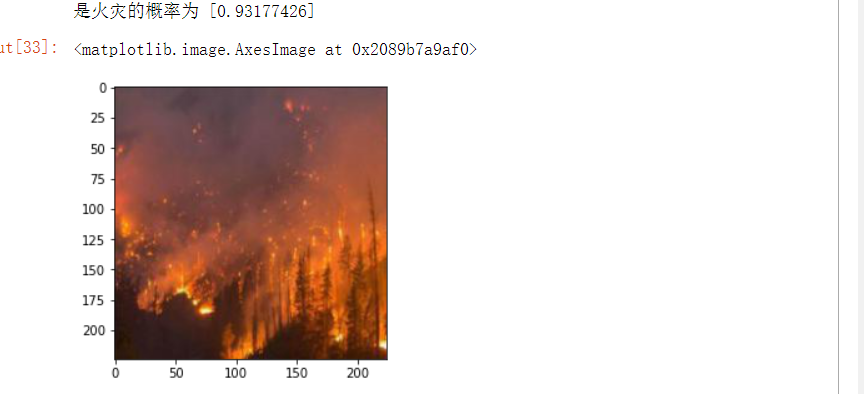
II. Multi classification
1. Prepare data set

2. Traverse the files in the dataset and generate DataFrame from path data and label data
1 dir = Path('D:/python Curriculum design 1') 2 3 # use glob Traversal in dir All in path jpg Format and add all file names to the filepaths In the list 4 filepaths = list(dir.glob(r'**/*.jpg')) 5 6 # Separate the divided small file name (category name) in the file and add it to the labels In the list of 7 labels = list(map(lambda l: os.path.split(os.path.split(l)[0])[1], filepaths)) 8 9 # take filepaths adopt pandas Convert to Series data type 10 filepaths = pd.Series(filepaths, name='FilePaths').astype(str) 11 12 # take labels adopt pandas Convert to Series data type 13 labels = pd.Series(labels, name='Labels').astype(str) 14 15 # take filepaths and Series Two Series Data type composition for DataFrame data type 16 df = pd.merge(filepaths, labels, right_index=True, left_index=True) 17 df = df[df['Labels'].apply(lambda l: l[-2:] != 'GT')] 18 df = df.sample(frac=1).reset_index(drop=True)#View the data of the formed DataFrame
df
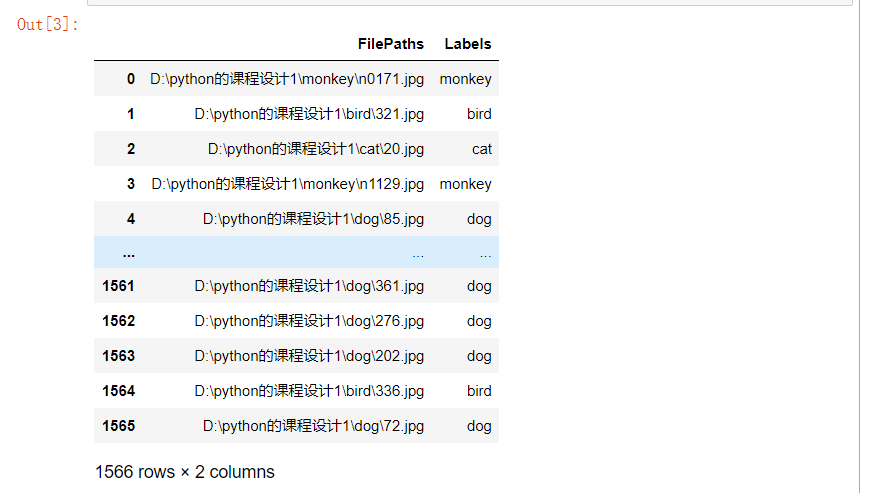
3. View the image and the corresponding label
1 fit, ax = plt.subplots(nrows=3, ncols=3, figsize=(10, 7)) 2 3 for i, a in enumerate(ax.flat): 4 a.imshow(plt.imread(df.FilePaths[i])) 5 a.set_title(df.Labels[i]) 6 7 plt.tight_layout() 8 plt.show()
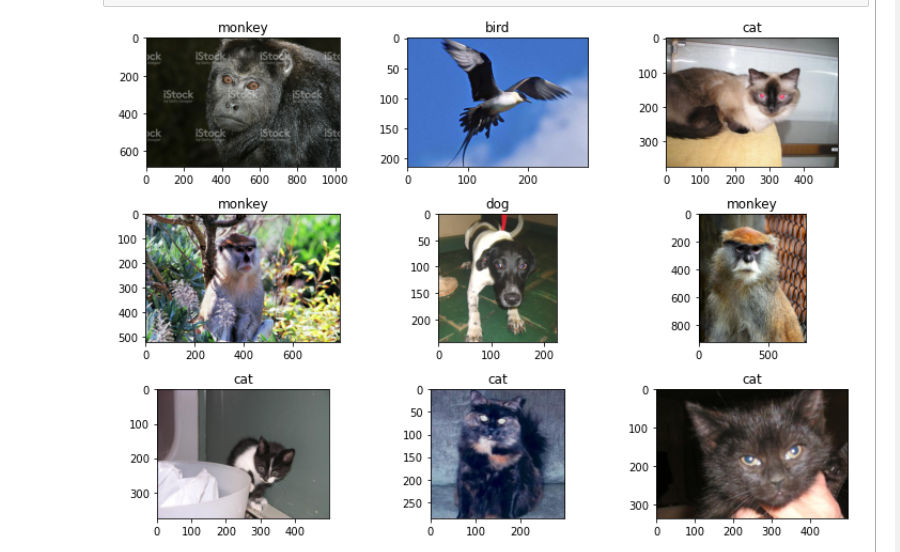
4. The training set, test set and verification set are generated from the total data set
#The total data is distributed to the users in a ratio of 10:1 X_train, X_test X_train, X_test = train_test_split(df, test_size=0.1, stratify=df['Labels']) print('Shape of Train Data: ', X_train.shape) print('Shape of Test Data: ', X_test.shape) # Press 5 for the total data:1 Proportion allocated to X_train, X_train X_train, X_val = train_test_split(X_train, test_size=0.2, stratify=X_train['Labels']) print('Shape of Train Data: ', X_train.shape) print('Shape of Val Data: ', X_val.shape) # View the number of pictures of each label X_train['Labels'].value_counts(ascending=True)

5. Image preprocessing
1 # Batch size 2 BATCH_SIZE = 32 3 # Enter the size of the picture 4 IMG_SIZE = (224, 224) 5 6 # Image preprocessing 7 img_data_gen = ImageDataGenerator(preprocessing_function=preprocess_input) 8 9 10 X_train = img_data_gen.flow_from_dataframe(dataframe=X_train, 11 x_col='FilePaths', 12 y_col='Labels', 13 target_size=IMG_SIZE, 14 color_mode='rgb', 15 class_mode='categorical', 16 batch_size=BATCH_SIZE, 17 seed=42) 18 19 X_val = img_data_gen.flow_from_dataframe(dataframe=X_val, 20 x_col='FilePaths', 21 y_col='Labels', 22 target_size=IMG_SIZE, 23 color_mode='rgb', 24 class_mode='categorical', 25 batch_size=BATCH_SIZE, 26 seed=42) 27 X_test = img_data_gen.flow_from_dataframe(dataframe=X_test, 28 x_col='FilePaths', 29 y_col='Labels', 30 target_size=IMG_SIZE, 31 color_mode='rgb', 32 class_mode='categorical', 33 batch_size=BATCH_SIZE, 34 seed=42)

6. View the processed image and its one hot tag
1 fit, ax = plt.subplots(nrows=2, ncols=3, figsize=(13,7)) 2 3 for i, a in enumerate(ax.flat): 4 img, label = X_train.next() 5 a.imshow(img[0],) 6 a.set_title(label[0]) 7 8 plt.tight_layout() 9 plt.show()
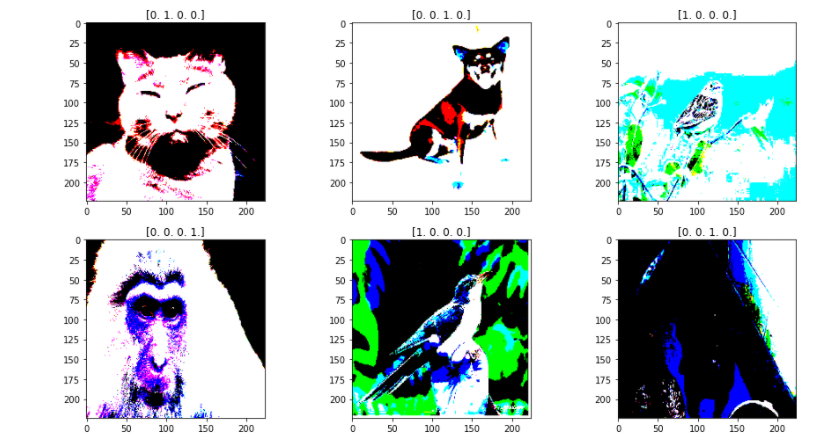
7. Constructing neural network and training model
1 model = Sequential() 2 # Data normalization processing 3 model.add(tf.keras.layers.experimental.preprocessing.Rescaling(1./255)) 4 5 # 1.Conv2D Layer, 32 filters 6 model.add(Conv2D(filters=32, kernel_size=(3,3), padding='same', input_shape=(224, 224, 3)))#The graphics are color,'rgb',So set 3 7 model.add(Activation('relu')) 8 model.add(MaxPooling2D(pool_size=(2,2), strides=2, padding='valid')) 9 10 # 2.Conv2D Layer, 64 filters 11 model.add(Conv2D(filters=64, kernel_size=(3,3), padding='same')) 12 model.add(Activation('relu')) 13 model.add(MaxPooling2D(pool_size=(2,2), strides=2, padding='valid')) 14 15 # 3.Conv2D Layer, 128 filters 16 model.add(Conv2D(filters=128, kernel_size=(3,3), padding='same')) 17 model.add(Activation('relu')) 18 model.add(MaxPooling2D(pool_size=(2,2), strides=2, padding='valid')) 19 20 # The data of the input layer is compressed into one-dimensional data, and the full connection layer can only process one-dimensional data 21 model.add(Flatten()) 22 23 # Full connection layer 24 model.add(Dense(256)) 25 model.add(Activation('relu')) 26 27 # Reduce overfitting 28 model.add(Dropout(0.5)) 29 30 # Full connection layer 31 model.add(Dense(4))#There are four categories to be identified 32 model.add(Activation('softmax'))#softmax It is based on binary classification function sigmoid Multi classification function 33 34 # Model compilation 35 model.compile(optimizer=optimizers.RMSprop(lr=1e-4), 36 loss="categorical_crossentropy", 37 metrics=["accuracy"]) 38 #Training model using batch generator 39 h1 = model.fit(X_train, validation_data=X_val, 40 epochs=30, ) 41 #Save model 42 model.save('h21')
8. Draw loss curve and accuracy curve
1 accuracy = h1.history['accuracy'] 2 loss = h1.history['loss'] 3 val_loss = h1.history['val_loss'] 4 val_accuracy = h1.history['val_accuracy'] 5 plt.figure(figsize=(17, 7)) 6 plt.subplot(2, 2, 1) 7 plt.plot(range(30), accuracy,'bo', label='Training Accuracy') 8 plt.plot(range(30), val_accuracy, label='Validation Accuracy') 9 plt.legend(loc='lower right') 10 plt.title('Accuracy : Training vs. Validation ') 11 plt.subplot(2, 2, 2) 12 plt.plot(range(30), loss,'bo' ,label='Training Loss') 13 plt.plot(range(30), val_loss, label='Validation Loss') 14 plt.title('Loss : Training vs. Validation ') 15 plt.legend(loc='upper right') 16 plt.show()

9. Data enhancement with ImageDataGenerator
train_datagen = ImageDataGenerator(rescale=1./255, rotation_range=40, #Rotate the image randomly by 40 degrees width_shift_range=0.2, #The translation scale in the horizontal direction is 0.2 height_shift_range=0.2, #The translation scale in the vertical direction is 0.2 shear_range=0.2, #The angle of random staggered transformation is 0.2 zoom_range=0.2, #The range of random scaling of the picture is 0.2 horizontal_flip=True, #Randomly flip half the image horizontally fill_mode='nearest') #Fill create pixels X_val1 = ImageDataGenerator(rescale=1./255) X_train1 = train_datagen.flow_from_dataframe( X_train, target_size=(150,150), batch_size=32, class_mode='categorical' ) X_val1= test_datagen.flow_from_dataframe( X_test, target_size=(150,150), batch_size=32, class_mode='categorical')
Train the model again, draw the loss curve and accuracy curve, and get the result graph

10. Import pictures for prediction
1 from PIL import Image 2 def con(file,outdir,w=224,h=224): 3 img1=Image.open(file) 4 img2=img1.resize((w,h),Image.BILINEAR) 5 img2.save(os.path.join(outdir,os.path.basename(file))) 6 file='D:/python Curriculum design of/forecast/414.jpg' 7 con(file,'D:/python Curriculum design of/forecast/') 8 model=load_model('h20') 9 img_path='D:/python Curriculum design of/forecast/414.jpg' 10 img = load_img(img_path) 11 img = img_to_array(img) 12 img = np.expand_dims(img, axis=0) 13 out = model.predict(img) 14 print(out) 15 dict={'0':'bird','1':'cat','2':'dog','3':'monkey'} 16 for i in range(4): 17 if out[0][i]>0.5: 18 print(dict[str(i)]) 19 img=plt.imread('D:/python Curriculum design of/forecast/414.jpg') 20 plt.imshow(img)
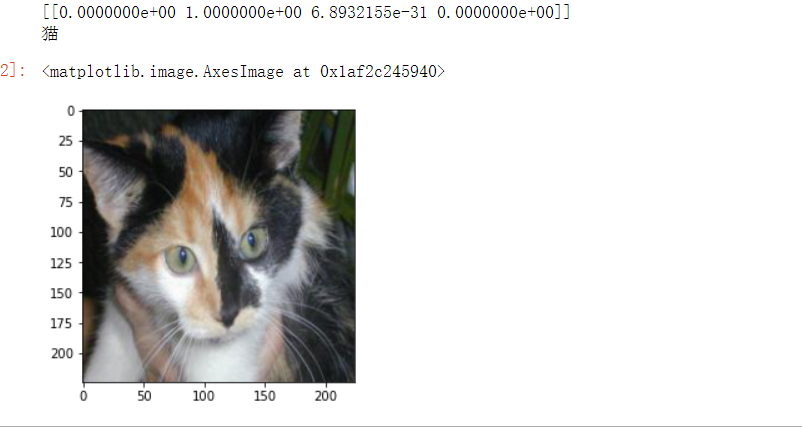
1 file='D:/python Curriculum design of/forecast/512.jpg' 2 con(file,'D:/python Curriculum design of/forecast/') 3 model=load_model('h20') 4 img_path='D:/python Curriculum design of/forecast/512.jpg' 5 img = load_img(img_path) 6 img = img_to_array(img) 7 img = np.expand_dims(img, axis=0) 8 out = model.predict(img) 9 print(out) 10 dict={'0':'bird','1':'cat','2':'dog','3':'monkey'} 11 for i in range(4): 12 if out[0][i]>0.5: 13 print(dict[str(i)]) 14 img=plt.imread('D:/python Curriculum design of/forecast/512.jpg') 15 plt.imshow(img)
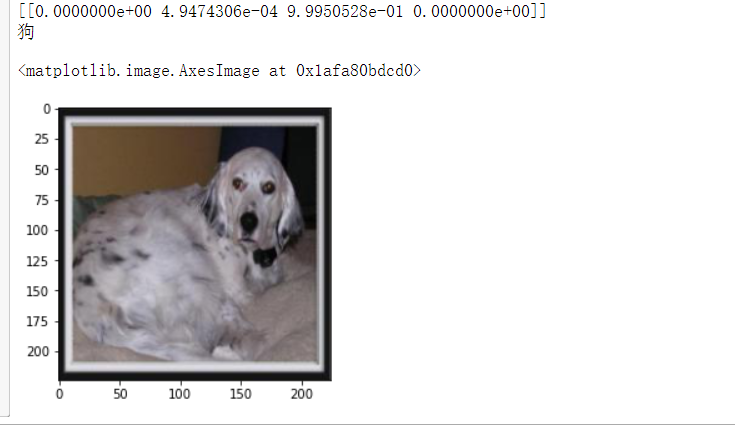
1 file='D:/python Curriculum design of/forecast/n3044.jpg' 2 con(file,'D:/python Curriculum design of/forecast/') 3 model=load_model('h20') 4 img_path='D:/python Curriculum design of/forecast/n3044.jpg' 5 img = load_img(img_path) 6 img = img_to_array(img) 7 img = np.expand_dims(img, axis=0) 8 out = model.predict(img) 9 print(out) 10 dict={'0':'bird','1':'cat','2':'dog','3':'monkey'} 11 for i in range(4): 12 if out[0][i]>0.5: 13 print(dict[str(i)]) 14 img=plt.imread('D:/python Curriculum design of/forecast/n3044.jpg') 15 plt.imshow(img)
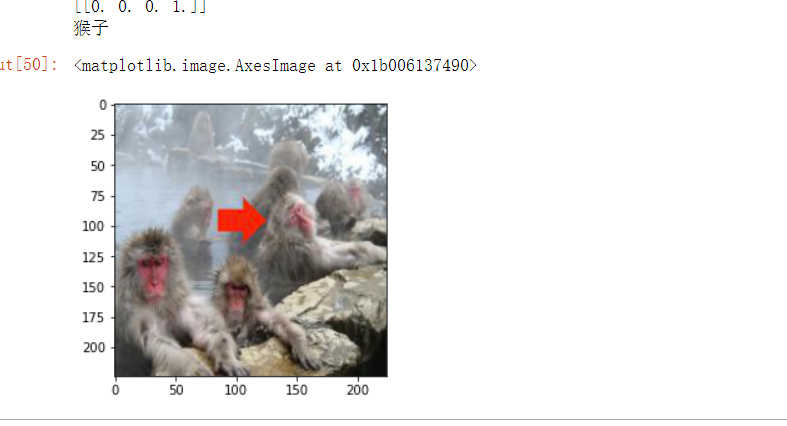
All codes are attached:
1 #Import required libraries 2 import numpy as np 3 import pandas as pd 4 import os 5 import tensorflow as tf 6 import matplotlib.pyplot as plt 7 from pathlib import Path 8 from sklearn.model_selection import train_test_split 9 from keras.models import Sequential 10 from keras.layers import Activation 11 from keras.layers import Dense, Dropout, Flatten, Conv2D, MaxPooling2D 12 from keras.applications.resnet import preprocess_input 13 from keras_preprocessing.image import ImageDataGenerator 14 from keras.models import load_model 15 from keras.preprocessing.image import load_img, img_to_array 16 from keras import optimizers 17 18 dir = Path('D:/python Curriculum design of/fire') 19 20 # use glob Traversal in dir All in path jpg Format and add all file names to the filepaths In the list 21 filepaths = list(dir.glob(r'**/*.jpg')) 22 23 # Separate the divided small file names (category names) in the file and add them to the list of labels 24 labels = list(map(lambda l: os.path.split(os.path.split(l)[0])[1], filepaths)) 25 26 # Convert filepaths to Series data type through pandas 27 filepaths = pd.Series(filepaths, name='FilePaths').astype(str) 28 29 # Convert labels to Series data type through pandas 30 labels = pd.Series(labels, name='Labels').astype(str) 31 32 # Synthesize the data types of filepaths and Series into the DataFrame data type 33 df = pd.merge(filepaths, labels, right_index=True, left_index=True) 34 df = df[df['Labels'].apply(lambda l: l[-2:] != 'GT')] 35 df = df.sample(frac=1).reset_index(drop=True) 36 #View the data of the formed DataFrame 37 df 38 #View the image and the corresponding label 39 fit, ax = plt.subplots(nrows=3, ncols=3, figsize=(10, 7)) 40 41 for i, a in enumerate(ax.flat): 42 a.imshow(plt.imread(df.FilePaths[i])) 43 a.set_title(df.Labels[i]) 44 45 plt.tight_layout() 46 plt.show() 47 48 # The training set, test set and verification set are generated from the total data set 49 #Assign the total data to X in a ratio of 10:1_ train, X_ test 50 X_train, X_test = train_test_split(df, test_size=0.1, stratify=df['Labels']) 51 52 print('Shape of Train Data: ', X_train.shape) 53 print('Shape of Test Data: ', X_test.shape) 54 55 # Assign the total data to X in a ratio of 5:1_ train, X_ train 56 X_train, X_val = train_test_split(X_train, test_size=0.2, stratify=X_train['Labels']) 57 58 print('Shape of Train Data: ', X_train.shape) 59 print('Shape of Val Data: ', X_val.shape) 60 61 # View the number of pictures of each label 62 X_train['Labels'].value_counts(ascending=True) 63 64 # Batch size 65 BATCH_SIZE = 32 66 # Enter the size of the picture 67 IMG_SIZE = (224, 224) 68 69 # Image preprocessing 70 img_data_gen = ImageDataGenerator(preprocessing_function=preprocess_input) 71 72 X_train = img_data_gen.flow_from_dataframe(dataframe=X_train, 73 x_col='FilePaths', 74 y_col='Labels', 75 target_size=IMG_SIZE, 76 color_mode='rgb', 77 class_mode='binary', 78 batch_size=BATCH_SIZE, 79 seed=42) 80 81 X_val = img_data_gen.flow_from_dataframe(dataframe=X_val, 82 x_col='FilePaths', 83 y_col='Labels', 84 target_size=IMG_SIZE, 85 color_mode='rgb', 86 class_mode='binary', 87 batch_size=BATCH_SIZE, 88 seed=42) 89 X_test = img_data_gen.flow_from_dataframe(dataframe=X_test, 90 x_col='FilePaths', 91 y_col='Labels', 92 target_size=IMG_SIZE, 93 color_mode='rgb', 94 class_mode='binary', 95 batch_size=BATCH_SIZE, 96 seed=42) 97 98 #View the processed image and its binary tag 99 fit, ax = plt.subplots(nrows=2, ncols=3, figsize=(13,7)) 100 101 for i, a in enumerate(ax.flat): 102 img, label = X_train.next() 103 a.imshow(img[0],) 104 a.set_title(label[0]) 105 106 plt.tight_layout() 107 plt.show() 108 109 #Constructing neural network 110 model = Sequential() 111 # Data normalization processing 112 model.add(tf.keras.layers.experimental.preprocessing.Rescaling(1./255)) 113 114 # 1.Conv2D Layer, 32 filters 115 model.add(Conv2D(filters=32, kernel_size=(3,3), padding='same', input_shape=(224, 224, 3)))#The graphics are colored, 'rgb', so set 3 116 model.add(Activation('relu')) 117 model.add(MaxPooling2D(pool_size=(2,2), strides=2, padding='valid')) 118 119 # 2.Conv2D Layer, 64 filters 120 model.add(Conv2D(filters=64, kernel_size=(3,3), padding='same')) 121 model.add(Activation('relu')) 122 model.add(MaxPooling2D(pool_size=(2,2), strides=2, padding='valid')) 123 124 # 3.Conv2D Layer, 128 filters 125 model.add(Conv2D(filters=128, kernel_size=(3,3), padding='same')) 126 model.add(Activation('relu')) 127 model.add(MaxPooling2D(pool_size=(2,2), strides=2, padding='valid')) 128 129 # The data of the input layer is compressed into one-dimensional data, and the full connection layer can only process one-dimensional data 130 model.add(Flatten()) 131 132 # Full connection layer 133 model.add(Dense(256)) 134 model.add(Activation('relu')) 135 136 # Reduce overfitting 137 model.add(Dropout(0.5)) 138 139 # Full connection layer 140 model.add(Dense(1)) 141 model.add(Activation('sigmoid')) 142 143 # Model compilation 144 model.compile(optimizer=optimizers.RMSprop(lr=1e-4), 145 loss="categorical_crossentropy", 146 metrics=["accuracy"]) 147 #Training model using batch generator 148 h1 = model.fit(X_train, validation_data=X_val, 149 epochs=30, ) 150 #Save model 151 model.save('t1') 152 153 #Draw loss curve and accuracy curve 154 accuracy = h1.history['accuracy'] 155 loss = h1.history['loss'] 156 val_loss = h1.history['val_loss'] 157 val_accuracy = h1.history['val_accuracy'] 158 plt.figure(figsize=(17, 7)) 159 plt.subplot(2, 2, 1) 160 plt.plot(range(30), accuracy,'bo', label='Training Accuracy') 161 plt.plot(range(30), val_accuracy, label='Validation Accuracy') 162 plt.legend(loc='lower right') 163 plt.title('Accuracy : Training vs. Validation ') 164 plt.subplot(2, 2, 2) 165 plt.plot(range(30), loss,'bo' ,label='Training Loss') 166 plt.plot(range(30), val_loss, label='Validation Loss') 167 plt.title('Loss : Training vs. Validation ') 168 plt.legend(loc='upper right') 169 plt.show() 170 171 from PIL import Image 172 def con(file,outdir,w=224,h=224): 173 img1=Image.open(file) 174 img2=img1.resize((w,h),Image.BILINEAR) 175 img2.save(os.path.join(outdir,os.path.basename(file))) 176 file='D:/python Curriculum design / NA_Fish_Dataset/Black Sea Sprat/F_23.jpg' 177 con(file,'D:/python Curriculum design / NA_Fish_Dataset/Black Sea Sprat/') 178 model=load_model('t1') 179 img_path='D:/python Curriculum design / NA_Fish_Dataset/Black Sea Sprat/F_23.jpg' 180 img = load_img(img_path) 181 img = img_to_array(img) 182 img = np.expand_dims(img, axis=0) 183 out = model.predict(img) 184 if out[0]>0.5: 185 print('The probability of fire is',out[0]) 186 else: 187 print('Not a fire') 188 img=plt.imread('D:/python Curriculum design / NA_Fish_Dataset/Black Sea Sprat/F_23.jpg') 189 plt.imshow(img) 190 191 dir = Path('D:/python Curriculum design 1') 192 193 # Use glob to traverse all jpg files in the dir path, and add all file names to the file paths list 194 filepaths = list(dir.glob(r'**/*.jpg')) 195 196 # Separate the divided small file name (category name) in the file and add it to the labels In the list of 197 labels = list(map(lambda l: os.path.split(os.path.split(l)[0])[1], filepaths)) 198 199 # take filepaths adopt pandas Convert to Series data type 200 filepaths = pd.Series(filepaths, name='FilePaths').astype(str) 201 202 # take labels adopt pandas Convert to Series data type 203 labels = pd.Series(labels, name='Labels').astype(str) 204 205 # take filepaths and Series Two Series Data type composition for DataFrame data type 206 df = pd.merge(filepaths, labels, right_index=True, left_index=True) 207 df = df[df['Labels'].apply(lambda l: l[-2:] != 'GT')] 208 df = df.sample(frac=1).reset_index(drop=True) 209 210 #Constructing neural network 211 model = Sequential() 212 # Data normalization processing 213 model.add(tf.keras.layers.experimental.preprocessing.Rescaling(1./255)) 214 215 # 1.Conv2D Layer, 32 filters 216 model.add(Conv2D(filters=32, kernel_size=(3,3), padding='same', input_shape=(224, 224, 3)))#The graphics are color,'rgb',So set 3 217 model.add(Activation('relu')) 218 model.add(MaxPooling2D(pool_size=(2,2), strides=2, padding='valid')) 219 220 # 2.Conv2D Layer, 64 filters 221 model.add(Conv2D(filters=64, kernel_size=(3,3), padding='same')) 222 model.add(Activation('relu')) 223 model.add(MaxPooling2D(pool_size=(2,2), strides=2, padding='valid')) 224 225 # 3.Conv2D Layer, 128 filters 226 model.add(Conv2D(filters=128, kernel_size=(3,3), padding='same')) 227 model.add(Activation('relu')) 228 model.add(MaxPooling2D(pool_size=(2,2), strides=2, padding='valid')) 229 230 # The data of the input layer is compressed into one-dimensional data, and the full connection layer can only process one-dimensional data 231 model.add(Flatten()) 232 233 # Full connection layer 234 model.add(Dense(256)) 235 model.add(Activation('relu')) 236 237 # Reduce overfitting 238 model.add(Dropout(0.5)) 239 240 # Full connection layer 241 model.add(Dense(4))#There are four categories to be identified 242 model.add(Activation('softmax'))#softmax It is based on binary classification function sigmoid Multi classification function 243 244 # Model compilation 245 model.compile(optimizer=optimizers.RMSprop(lr=1e-4), 246 loss="categorical_crossentropy", 247 metrics=["accuracy"]) 248 #Training model using batch generator 249 h1 = model.fit(X_train, validation_data=X_val, 250 epochs=30, ) 251 #Save model 252 model.save('h21') 253 254 255 #Draw loss curve and accuracy curve 256 accuracy = h1.history['accuracy'] 257 loss = h1.history['loss'] 258 val_loss = h1.history['val_loss'] 259 val_accuracy = h1.history['val_accuracy'] 260 plt.figure(figsize=(17, 7)) 261 plt.subplot(2, 2, 1) 262 plt.plot(range(30), accuracy,'bo', label='Training Accuracy') 263 plt.plot(range(30), val_accuracy, label='Validation Accuracy') 264 plt.legend(loc='lower right') 265 plt.title('Accuracy : Training vs. Validation ') 266 plt.subplot(2, 2, 2) 267 plt.plot(range(30), loss,'bo' ,label='Training Loss') 268 plt.plot(range(30), val_loss, label='Validation Loss') 269 plt.title('Loss : Training vs. Validation ') 270 plt.legend(loc='upper right') 271 plt.show() 272 273 #definition ImageDataGenerator parameter 274 train_datagen = ImageDataGenerator(rescale=1./255, 275 rotation_range=40, #Rotate the image randomly by 40 degrees 276 width_shift_range=0.2, #The translation scale in the horizontal direction is 0.2 277 height_shift_range=0.2, #The translation scale in the vertical direction is 0.2 278 shear_range=0.2, #The angle of random staggered transformation is 0.2 279 zoom_range=0.2, #The range of random scaling of the picture is 0.2 280 horizontal_flip=True, #Randomly flip half the image horizontally 281 fill_mode='nearest') #Fill create pixels 282 283 X_val1 = ImageDataGenerator(rescale=1./255) 284 285 X_train1 = train_datagen.flow_from_dataframe( 286 X_train, 287 target_size=(150,150), 288 batch_size=32, 289 class_mode='categorical' 290 ) 291 292 X_val1= test_datagen.flow_from_dataframe( 293 X_test, 294 target_size=(150,150), 295 batch_size=32, 296 class_mode='categorical') 297 298 from PIL import Image 299 def con(file,outdir,w=224,h=224): 300 img1=Image.open(file) 301 img2=img1.resize((w,h),Image.BILINEAR) 302 img2.save(os.path.join(outdir,os.path.basename(file))) 303 file='D:/python Curriculum design of/forecast/414.jpg' 304 con(file,'D:/python Curriculum design of/forecast/') 305 model=load_model('h21') 306 img_path='D:/python Curriculum design of/forecast/414.jpg' 307 img = load_img(img_path) 308 img = img_to_array(img) 309 img = np.expand_dims(img, axis=0) 310 out = model.predict(img) 311 print(out) 312 dict={'0':'bird','1':'cat','2':'dog','3':'monkey'} 313 for i in range(4): 314 if out[0][i]>0.5: 315 print(dict[str(i)]) 316 img=plt.imread('D:/python Curriculum design of/forecast/414.jpg') 317 plt.imshow(img)
(4) Summary: the main content of this program design is the label learning of machine learning. Through this course design, I have deepened my understanding of machine learning and its label learning.
Machine learning is a method of using data, training models, and then model prediction. This study is mainly to practice two classification and multi classification. Secondary classification: the secondary classification function used is sigmoid, while the multi classification function used by softmax based on secondary classification. Sigmoid is used to nonlinearize each output value, while sofmax is used to calculate the specific gravity. The results of the two are similar and have the function of normalization. However, softmax is a process of normalization for the output result, and sigmoid is a nonlinear activation process, that is, when the output layer is a divine element, sigmoid will be used. Softmax is generally used in combination with one hot tag, It is generally used in the last layer of the network. Sigmoid is used with 0,1 real tags. When using softmax, the loss function should be set to categorical_ Crossintropy loss function, and when sigmoid is used, the loss function is set to binary_crossentropy loss function.
The deficiency of this program design: the effect of data enhancement is not very obvious, and the image distortion is encountered in the design process, resulting in the slow rise of training accuracy